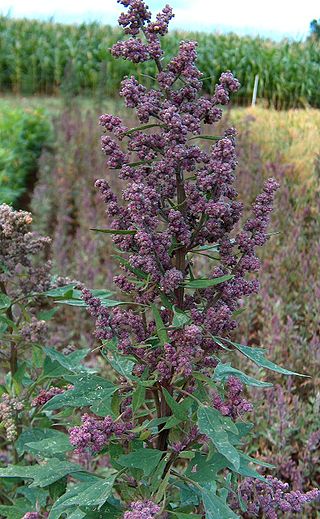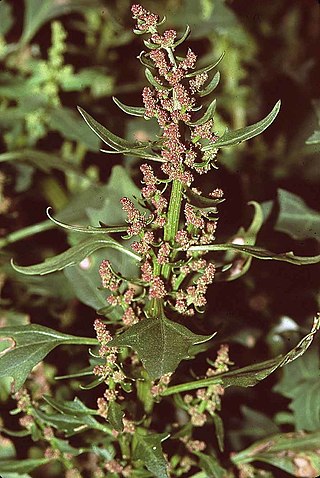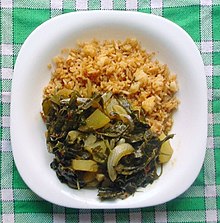
Amaranthus is a cosmopolitan group of more than 50 species which make up the genus of annual or short-lived perennial plants collectively known as amaranths. Some of the more well known names include "prostrate pigweed" and "love lies bleeding". Some amaranth species are cultivated as leaf vegetables, pseudocereals, and ornamental plants. Catkin-like cymes of densely packed flowers grow in summer or fall. Amaranth varies in flower, leaf, and stem color with a range of striking pigments from the spectrum of maroon to crimson and can grow longitudinally from 1 to 2.5 metres tall with a cylindrical, succulent, fibrous stem that is hollow with grooves and bracteoles when mature. There are approximately 75 species in the genus, 10 of which are dioecious and native to North America with the remaining 65 monoecious species endemic to every continent from tropical lowlands to the Himalayas. Members of this genus share many characteristics and uses with members of the closely related genus Celosia. Amaranth grain is collected from the genus. The leaves of some species are also eaten.

Quinoa is a flowering plant in the amaranth family. It is a herbaceous annual plant grown as a crop primarily for its edible seeds; the seeds are rich in protein, dietary fiber, B vitamins and dietary minerals in amounts greater than in many grains. Quinoa is not a grass but rather a pseudocereal botanically related to spinach and amaranth, and originated in the Andean region of northwestern South America. It was first used to feed livestock 5,200–7,000 years ago, and for human consumption 3,000–4,000 years ago in the Lake Titicaca basin of Peru and Bolivia.

Caraway, also known as meridian fennel and Persian cumin, is a biennial plant in the family Apiaceae, native to western Asia, Europe, and North Africa.

Beta vulgaris (beet) is a species of flowering plant in the subfamily Betoideae of the family Amaranthaceae. Economically, it is the most important crop of the large order Caryophyllales. It has several cultivar groups: the sugar beet, of greatest importance to produce table sugar; the root vegetable known as the beetroot or garden beet; the leaf vegetable known as chard or spinach beet or silverbeet; and mangelwurzel, which is a fodder crop. Three subspecies are typically recognised. All cultivars, despite their quite different morphologies, fall into the subspecies Beta vulgaris subsp. vulgaris. The wild ancestor of the cultivated beets is the sea beet.

Amaranthaceae is a family of flowering plants commonly known as the amaranth family, in reference to its type genus Amaranthus. It includes the former goosefoot family Chenopodiaceae and contains about 165 genera and 2,040 species, making it the most species-rich lineage within its parent order, Caryophyllales.

Chard or Swiss chard is a green leafy vegetable. In the cultivars of the Flavescens Group, the leaf stalks are large and often prepared separately from the leaf blade; the Cicla Group is the leafy spinach beet. The leaf blade can be green or reddish; the leaf stalks are usually white, yellow or red.

The Chenopodioideae are a subfamily of the flowering plant family Amaranthaceae in the APG III system, which is largely based on molecular phylogeny, but were included – together with other subfamilies – in the family Chenopodiaceae, or goosefoot family, in the Cronquist system.

Chenopodium is a genus of numerous species of perennial or annual herbaceous flowering plants known as the goosefoot, which occur almost anywhere in the world. It is placed in the family Amaranthaceae in the APG II system; older classification systems, notably the widely used Cronquist system, separate it and its relatives as Chenopodiaceae, but this leaves the rest of the Amaranthaceae polyphyletic. However, among the Amaranthaceae, the genus Chenopodium is the namesake member of the subfamily Chenopodioideae.

Chenopodium pallidicaule, known as cañihua, canihua or cañahua and also kaniwa, is a species of goosefoot, similar in character and uses to the closely related quinoa.

Chenopodium vulvaria, stinking goosefoot is a foul-smelling plant that grows on bare ground in coastal habitats in the Mediterranean region and is associated with dung heaps and disturbed ground inland. It is native to southern Europe and western Asia and has spread to northern Europe other temperate parts of the world, with agriculture.

Tetragonia tetragonioides, commonly called New Zealand spinach, Warrigal greens and other local names, is a flowering plant in the fig-marigold family (Aizoaceae). It is often cultivated as a leafy vegetable.

Chenopodium berlandieri, also known by the common names pitseed goosefoot, lamb's quarters, and huauzontle (Nahuatl) is an annual herbaceous plant in the family Amaranthaceae.

Oxybasis chenopodioides is a species of flowering plant in the family Amaranthaceae known by the common name saltmarsh goosefoot. It is native to Europe, Asia and parts of Africa, where it grows on bare mud in brackish hollows in coastal grassland, inland salt steppes and salty deserts. It has spread to similar habitats in both North and South America. Its habitat is an uncommon one and is threatened by agricultural improvement in many areas, but overall its populations are stable. This species often grows with, and is easily confused with the closely-related red goosefoot.
Chenopodium fremontii is a species of flowering plant in the family Amaranthaceae known by the common name Frémont's goosefoot. Both the species' specific epithet, and the common name derive from the 19th century western pioneer John C. Frémont.

Chenopodium hians is a species of flowering plant in the family Amaranthaceae known by the common names hians goosefoot and gaping goosefoot. The Latin species name hians means "gaping".

Chenopodium giganteum, also known as tree spinach, is an annual, upright many-branched shrub with a stem diameter of up to 5 cm at the base, that can grow to a height of up to 3 m.
Chenopodium cycloides is a species of flowering plant in the family Amaranthaceae known by the common name sandhill goosefoot. It is native to the south-central United States.

Oxybasis is a flowering plant genus from the subfamily Chenopodioideae of the family Amaranthaceae. It was first described in 1841, and newly used since 2012 for five species that were traditionally grouped into genus Chenopodium. They occur in Europe, Asia, North Africa and America.

Lipandra polysperma, common name manyseed goosefoot, is the only species of the monotypic plant genus Lipandra from the subfamily Chenopodioideae of the family Amaranthaceae.





















